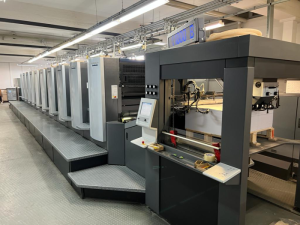Indian commercial printing capacity is set to continue to rise in the current financial year from 1 April 2023 to 31 March 2024 with both offset and digital press installations rising, and digital presses set to exceed pre-Covid levels. Many of the current offset installations are of machines delayed by delivery constraints of the manufacturers or the infrastructure delays of the printers.
Although the supply chains and chip shortages have eased, the average delivery time of any multicolor offset press to the Indian market is now at 6 to 8 months from firm order. While Manroland Sheetfed says it could deliver in December or January, Heidelberg India says it could deliver in six months and Komori says it would take seven months and RMGT is saying eight months. The implication is that unless an odd machine with the right configuration becomes available by chance, fresh orders taken in June could arrive in December 2023, but more likely from January to March 2024.
IppStar (www.ippstar.org) informally forecasts that the current year’s commercial and book press installations, including last year’s carryovers in the commercial market, will predominantly be of 4-color presses – but that the trend of 8-color perfecters will continue to gain traction. Apart from the new two-color perfecters and the 4-color machines, five to seven 8-color perfecters should be installed by March next year. It is likely these will include three or four good quality, automated used machines, and perhaps one or two brand new 8-color perfecters.

On the other hand, the toner-based digital presses are generally available from the warehouses of the companies within the country and can be installed within two to four weeks of order placement. The imported inkjet presses do take longer as they are specially configured as per order. There has been a significant increase in the number of new monochrome and color digital presses of all types, including drum and toner and inkjet presses installed by book printers in the 2022-23 financial year and especially in Q4 (January to March 2023).
Digital production press installs resume pre-pandemic trajectory
According to the back-of-the-envelope data collected by IppStar for FY 22-23, the digital press manufacturers and their distribution set-ups and channel partners in India are ebullient about the significant upswing in installations in Q4 (January-March 2023) of the last financial year. Estimates for that year’s production printer installs, discounting the very light office-type printers and machines, put the installs of production digital presses at about 1,750 units, including approximately 1,350 color presses and 400 monochrome digital presses.
In the current 23-24 financial year, most of the vendors are optimistic of another record-breaking year that will resume the trajectory toward 2,000 installations of imported production digital presses. Generally, many vendors look at numbers that include light production and other multifunction printers that tend to slightly inflate the numbers and possibly confuse the hardcore printing industry.
The IppStar estimates are slightly more modest or realistic and take into account only what we consider color and monochrome production digital presses. After speaking with several industry experts and insiders and customers, and considering the strong positive industry sentiment, IppStar estimates that the number of production machines will be closer to 1950 installations in the current financial year to 31 March 2024. Even then, there is a wide variety in the price and productivity and the configurations and technologies of the equipment available.
According to industry experts, some of the visible trends include the increased interest in B2 digital presses. Apart from the HP Indigo B2 presses that maintain their steady pace in the Indian market, another B2 sheetfed inkjet press, the KM1e has just been sold into the market after a gap of six years by Konica Minolta India. Other trends include the interest in lateral markets such as security and industrial printing and the continued interest in added special colors and metallic and haptic effects beyond CMYK. Here the Fujifilm Revoria has tracked good numbers in its initial full year of sales, and more than 100 Ricoh digital presses were installed in the past financial year.

The trend for value-added decoration is also strengthening with the KM-MG1 continuing to do well, and also Monotech’s locally manufactured decoration machines finding early adopters. It is anticipated that the new model Scodix may also garner some share of this market at the higher price end.
Sheet and web-fed inkjet digital presses
At the same time, web-fed inkjet digital book presses are gaining traction. One web-fed Screen 520 press has been installed in the past year, and two web-fed inkjet book presses from China have been installed by Insight Communications. The Indian inkjet book presses manufactured by Monotech, Vinsak, and a third supplier are making inroads among book printers and exporters.
Monotech has installed a pair of its Novel inkjet book presses in the past year with another press on order in the current year. It expects to sell as many as ten Novel inkjet book presses in the current year within the country and to also export a few of these with locally manufactured inline folding capabilities as an option.

Transactional digital print
Transactional print in India, which never reached great success in the personalized marketing domain, nevertheless persists as a growing industry with its leading proponents now adding locally built inkjet presses using a variety of imported inkjet heads and arrays. Monotech and Vinsak are active in this market as they push the envelope to reach the expectations of their demanding customers weaned on imported presses and inkjet heads. Nevertheless, they are still searching for cost-effective in-line finishing and binding system options – perhaps the next challenge for Chinese and Indian manufacturers.


















